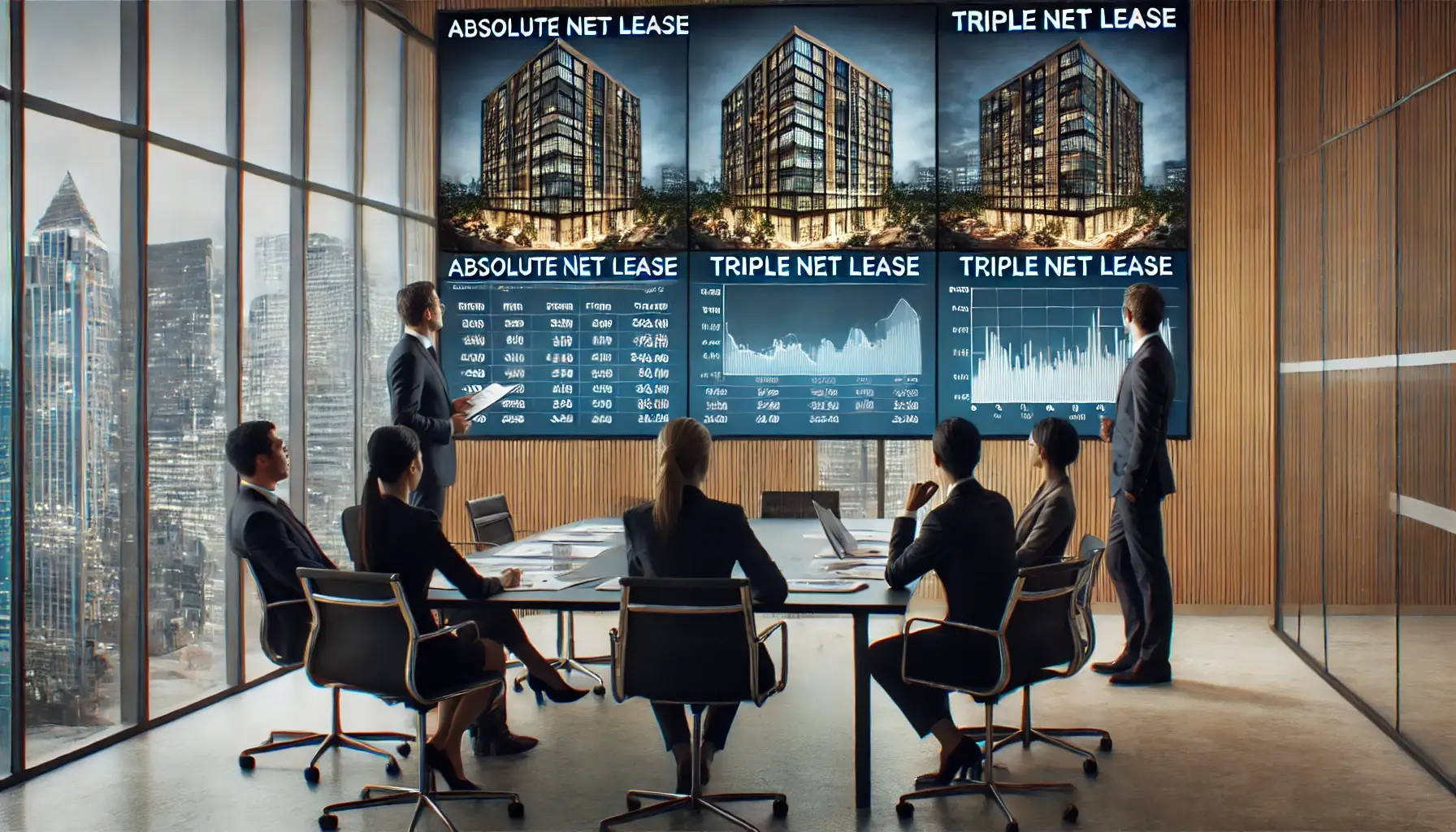Absolute Net Lease vs Triple Net Lease in Commercial Real Estate

Introduction

Understanding the various net lease structures in commercial real estate is crucial for investors and tenants alike. These lease types, particularly the absolute net lease and the triple net lease, play a significant role in determining the financial responsibilities and obligations of both parties involved.
In the commercial real estate sector, net leases are commonly used to outline the terms under which tenants will occupy and use properties. Unlike gross leases, where landlords cover most property expenses, net leases transfer a portion, or all, of these expenses to the tenant. The two primary types of net leases are the absolute net lease and the triple net lease, each with its own set of characteristics and financial implications.
Grasping the differences between absolute net leases and triple net leases is essential for making informed decisions in commercial real estate investments. An absolute net lease typically requires tenants to bear all property-related expenses, including maintenance, insurance, and taxes. In contrast, a triple net lease (NNN) places responsibility for property taxes, insurance, and maintenance costs on the tenant, but with certain nuances in obligation levels. Knowing these distinctions helps in selecting the most suitable lease type based on financial goals and property management preferences.
What is the Difference Between an Absolute Net Lease and a Triple Net Lease?
Key Differences
An absolute net lease and a triple net lease are two prevalent types of net leases in commercial real estate. While both require the tenant to assume various property expenses, the extent of these responsibilities varies significantly.
Absolute Net Lease
An absolute net lease mandates that the tenant is responsible for all property-related expenses without exception. This includes maintenance, insurance, property taxes, and even structural repairs. Essentially, the tenant assumes the role of the property owner for all practical purposes.
Triple Net Lease (NNN)
In a triple net lease, the tenant also covers property taxes, insurance, and maintenance costs. However, unlike an absolute net lease, the landlord might still handle some structural repairs. The triple net lease is structured to ensure that the tenant covers the operating expenses while the landlord retains some responsibility for major repairs.
Comparison of Responsibilities and Financial Obligations
Understanding the distinctions in financial obligations between these two lease types is critical:
- Maintenance Costs: In an absolute net lease, the tenant handles all maintenance, including structural repairs. In a triple net lease, the tenant covers most maintenance costs, but the landlord may handle some significant structural repairs.
- Insurance: Both lease types require the tenant to pay insurance premiums. However, in an absolute net lease, the tenant often manages comprehensive insurance, covering all potential liabilities and property damage.
- Property Taxes: Tenants in both lease types pay property taxes, but the extent of this responsibility can differ slightly based on the lease agreement specifics.
Lease Structure
The structure of these leases defines how responsibilities are divided between tenants and landlords, impacting financial planning and property management.
- Absolute Net Lease: The tenant's obligations are extensive, covering every possible expense related to the property. This type of lease is more favorable for landlords who prefer minimal involvement in property management.
- Triple Net Lease: This lease is more common and spreads the financial load, with the tenant covering operational costs and the landlord handling significant structural repairs.
For tenants, choosing between these leases involves evaluating their capacity to handle extensive property management duties and financial burdens. For landlords, the choice affects their involvement in property upkeep and their potential returns on investment.
For additional information on net leases, visit Investopedia.com.
Which Lease Type is Right for Commercial Real Estate?

Property Taxes Responsibilities
When choosing between an absolute net lease and a triple net lease, understanding property tax responsibilities is crucial. In an absolute net lease, the tenant is responsible for all property taxes, leaving no financial burden on the landlord. This full transfer of tax liability means tenants must account for potential increases in tax rates over time.
Conversely, in a triple net lease, the tenant also pays property taxes, but the landlord may retain some oversight. This can provide a layer of protection for the tenant, ensuring that tax assessments and payments are managed accurately. However, tenants must still budget for these taxes as part of their ongoing expenses.
For more details on investment loans related to property taxes, refer to Richiest.com.
Maintenance Costs Considerations
Maintenance costs are another key factor in deciding the right lease type. An absolute net lease requires the tenant to handle all maintenance expenses, including significant structural repairs. This can lead to higher upfront costs for tenants but offers landlords a hassle-free arrangement.
In a triple net lease, tenants cover most maintenance costs, such as regular upkeep and minor repairs. However, landlords might still be responsible for major structural repairs. This division of responsibilities can make a triple net lease more attractive to tenants who prefer a shared approach to property maintenance.
Insurance Premiums Coverage
Insurance responsibilities differ significantly between these lease types. In an absolute net lease, the tenant typically assumes all insurance costs, covering comprehensive property and liability insurance. This means the tenant must be diligent in obtaining adequate coverage to protect against all potential risks.
Under a triple net lease, the tenant also pays for insurance, but there may be some shared responsibilities with the landlord. This can result in a more balanced approach to managing insurance expenses, with both parties ensuring the property is adequately covered.
For more insights on insurance coverage in net leases, visit Stratafolio.com.
Understanding the Responsibilities of Tenant and Landlord in Net Leases

Tenant's Responsibilities in NNN Lease
In a triple net lease (NNN), the tenant takes on numerous responsibilities, making it crucial for potential tenants to understand what they are signing up for. The primary obligations include:
- Property Taxes: The tenant is responsible for paying property taxes, which means they must keep track of tax due dates and amounts.
- Insurance: Tenants must procure and maintain property and liability insurance, ensuring that the property is fully covered against potential risks.
- Maintenance: Regular maintenance, including repairs and upkeep, falls under the tenant's purview. This covers everything from landscaping to fixing building systems.
- Utilities: The tenant pays for all utilities, including water, electricity, and gas, ensuring that the property remains functional and habitable.
For more detailed information on managing investment properties, refer to Richiest.com.
Landlord's Obligations in Absolute Net Lease
In an absolute net lease, the landlord's responsibilities are minimal compared to those in other lease structures. The primary duties include:
- Lease Oversight: While the tenant handles most aspects of property management, the landlord must oversee the lease agreement to ensure compliance and address any issues that arise.
- Major Structural Repairs: Though rare, there are instances where the landlord may need to step in for significant structural repairs, depending on the lease terms.
The minimal involvement makes absolute net leases attractive to landlords who prefer a hands-off investment approach. However, it is essential for landlords to ensure that tenants are capable of managing the extensive responsibilities assigned to them.
Benefits and Drawbacks of Absolute Net Lease Vs Triple Net Lease
Long-Term Lease Advantages
When considering long-term lease agreements in commercial real estate, both absolute net leases and triple net leases offer distinct advantages and drawbacks.
Absolute Net Lease
Advantages
- Minimal Landlord Involvement: Landlords have little to no management responsibilities, making this lease type ideal for passive income.
- Predictable Income: Since tenants cover all expenses, landlords enjoy a steady income without unexpected costs.
Drawbacks
- Tenant Reliability: The success of this lease depends heavily on the tenant's ability to manage and maintain the property.
- Limited Control: Landlords have less control over property maintenance and management decisions.
Triple Net Lease (NNN)
Advantages
- Shared Responsibilities: While tenants handle most expenses, landlords may still oversee major structural repairs, ensuring property standards.
- Appeals to Tenants: Tenants might prefer this arrangement due to the balance of responsibilities, potentially attracting a wider range of tenants.
Drawbacks
- Partial Landlord Involvement: Landlords must still engage in property management to some extent, which might not appeal to those seeking complete hands-off investments.
- Variable Costs: Tenants might face fluctuating expenses due to maintenance and repair responsibilities.
For additional insights on the role of investment advisors in long-term lease agreements, refer to Richiest.com.
Repair and Maintenance Costs Comparison
Absolute Net Lease
In an absolute net lease, the tenant is responsible for all repair and maintenance costs. This includes routine maintenance and significant structural repairs. This arrangement transfers all financial risks associated with property upkeep to the tenant.
Triple Net Lease (NNN)
Under a triple net lease, tenants handle most maintenance and repair costs. However, landlords might retain responsibility for major structural repairs. This shared approach can help balance the financial burden between the tenant and the landlord.
Understanding these differences in cost responsibilities is vital for both tenants and landlords to ensure the lease agreement aligns with their financial strategies and risk tolerance.
Exploring Various Types of Commercial Real Estate Leases
Gross Lease Structure in Commercial Properties
A gross lease is a type of commercial lease where the landlord covers most, if not all, property-related expenses. These expenses typically include property taxes, insurance, and maintenance costs. Tenants pay a single, fixed rent amount, simplifying their financial planning.
Advantages of Gross Leases
- Simplified Payments: Tenants make one payment without worrying about additional costs.
- Predictable Expenses: Fixed rent makes budgeting easier for tenants.
Disadvantages of Gross Leases
- Higher Rent: Landlords often set higher rent to cover all expenses, which might deter some tenants.
- Limited Control: Tenants have less control over maintenance and utility expenses since these are managed by the landlord.
Types of Net Leases Used by Real Estate Investors
Net leases are popular among real estate investors due to their varying degrees of tenant responsibility. There are three main types of net leases:
Single Net Lease (N Lease)
In a single net lease, the tenant is responsible for paying property taxes in addition to rent. The landlord covers insurance and maintenance costs. This type of lease is less common but offers a balance of responsibilities between the landlord and tenant.
Double Net Lease (NN Lease)
A double net lease requires the tenant to pay for property taxes and insurance premiums, while the landlord handles maintenance costs. This lease type is more common in commercial real estate and provides a moderate level of responsibility for tenants.
Triple Net Lease (NNN Lease)
The triple net lease is the most tenant-responsible net lease, where tenants pay property taxes, insurance, and maintenance costs. This lease type reduces the landlord's financial burden and is highly favored for its ability to generate passive income.
For a detailed explanation of triple net leases, refer to Wellbornre.com.
Conclusion
In the world of commercial real estate, choosing the right lease arrangement is crucial. An absolute net lease in commercial real estate is a lease where the tenant is responsible for property taxes, insurance, and maintenance, making it a comprehensive option. Net leases, including an absolute net lease and a triple net lease (also known as a bondable lease), are used widely by commercial real estate investors due to their predictable income streams.
The decision between an absolute net lease and a triple net lease may depend on the specific needs and capabilities of the tenant and landlord. An absolute net lease may provide landlords with minimal management responsibilities, while a triple net lease gives tenants control over property expenses. Unlike other lease structures, net leases and bond leases transfer many costs to the tenant, which can be beneficial in longer lease terms.
Net lease properties, including absolute triple net leases, are known for their stability and lower risk. Commercial real estate loans often favor these lease types due to their reliable cash flow. Net leases provide clear terms of the lease, making it easier for both parties to understand their responsibilities. In comparison to gross and net leases, the advantages of an absolute net lease are evident in the lower involvement required from landlords and the financial predictability it offers. For investors, net lease investments represent a sound strategy in commercial real estate.
FAQs
What is an absolute net lease?
An absolute net lease requires the tenant to cover all property-related expenses. This includes property taxes, insurance, maintenance, and even significant structural repairs. The tenant assumes full financial responsibility, similar to owning the property outright.
How does a triple net lease benefit tenants?
A triple net lease (NNN) can benefit tenants by often offering lower base rent compared to gross leases. Tenants also have more control over the property's operational expenses, such as maintenance and utilities, allowing for potential cost-saving measures.
What are the risks associated with absolute net leases?
The primary risks for tenants in an absolute net lease include the high level of financial responsibility for all property-related expenses. Unexpected costs for major repairs or tax increases can significantly impact the tenant's budget. For landlords, the main risk is relying on the tenant's ability to manage these extensive responsibilities effectively.
Can a lease type change during the lease term?
Lease modifications can occur during the lease term if both parties agree to the changes. These modifications might involve renegotiating responsibilities for expenses or adjusting the lease structure based on new financial circumstances or property needs.
How do net leases affect commercial real estate investment?
Net leases can significantly impact commercial real estate investment by providing predictable income streams for landlords. These leases often attract investors looking for stable, long-term returns with minimal management responsibilities. However, the specific type of net lease can influence the risk and return profile of the investment.
For more insights on multi-family property investment, refer to Richiest.com.